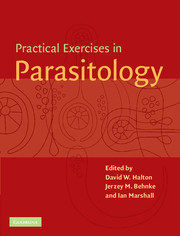Book contents
- Frontmatter
- Contents
- List of contributors
- Preface
- General advice
- 1 Observational Exercises on Parasites
- 2 Ecology
- 3 Physiology and Biochemistry
- 4 Pathology and Immunology
- 5 Chemotherapy
- 6 Molecular Parasitology
- 7 Behaviour
- 7.1 Behaviour of the miracidia of Fasciola hepatica and demonstration of other larval stages
- 7.2 Effects of age and environmental factors on the swimming behaviour of the cercariae of Cryptocotyle lingua (Trematoda)
- 7.3 Changes in host behaviour as a consequence of parasite infection
- 7.4 Behaviour of the amphipod Gammarus pulex, infected with cystacanths of acanthocephalans
- 7.5 Effects of Schistocephalus solidus (Cestoda) on stickleback feeding behaviour
- Appendix 1 Reagent index
- Appendix 2 UK suppliers
- Appendix 3 US suppliers
- Index
7.2 - Effects of age and environmental factors on the swimming behaviour of the cercariae of Cryptocotyle lingua (Trematoda)
Published online by Cambridge University Press: 05 June 2012
- Frontmatter
- Contents
- List of contributors
- Preface
- General advice
- 1 Observational Exercises on Parasites
- 2 Ecology
- 3 Physiology and Biochemistry
- 4 Pathology and Immunology
- 5 Chemotherapy
- 6 Molecular Parasitology
- 7 Behaviour
- 7.1 Behaviour of the miracidia of Fasciola hepatica and demonstration of other larval stages
- 7.2 Effects of age and environmental factors on the swimming behaviour of the cercariae of Cryptocotyle lingua (Trematoda)
- 7.3 Changes in host behaviour as a consequence of parasite infection
- 7.4 Behaviour of the amphipod Gammarus pulex, infected with cystacanths of acanthocephalans
- 7.5 Effects of Schistocephalus solidus (Cestoda) on stickleback feeding behaviour
- Appendix 1 Reagent index
- Appendix 2 UK suppliers
- Appendix 3 US suppliers
- Index
Summary
Aims and objectives
This exercise is designed to demonstrate that:
Parasite behaviour alters with age.
Swimming behaviour is influenced by environmental factors.
Parasites have evolved sensory mechanisms that are receptive to specific stimuli encountered during their active life.
The exercise also aims to:
Encourage students to consider the role of the observed responses in parasite dispersal.
Stimulate students to reflect on behavioural strategies that may lead to successful transmission.
Engage students in a critical debate relating to experimental design and the limitations of laboratory-based experimental models.
Introduction
The experiments described below investigate the swimming responses of the cercariae of the digenetic trematode, Cryptocotyle lingua. The swimming behaviour of cercariae may be adapted to ensure dispersal and infection of a host species. Some species show particularly high swimming activity after being shed (Haas et al., 1994). This clearly contributes to escape from the host snail's habitat and assists dispersion. Most cercariae tend to disperse in particular habitats by responding to environmental stimuli, such as gravity, light, water currents, temperature, ionic content and physical boundaries (MacInnis, 1976). Combes et al. (1994) suggested that dispersion had both demographic and genetic consequences. It may facilitate an encounter with a host and limit inbreeding. Other non-adult stages, such as eggs, cysts and some larvae, cannot respond to environmental signals by active processes and are transmitted by passive means. Cercarial host-finding behaviour patterns and the environmental cues that stimulate them have been analysed.
- Type
- Chapter
- Information
- Practical Exercises in Parasitology , pp. 407 - 414Publisher: Cambridge University PressPrint publication year: 2001
- 1
- Cited by



